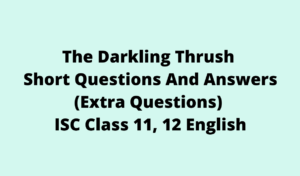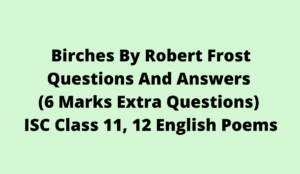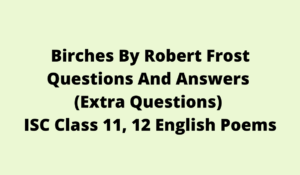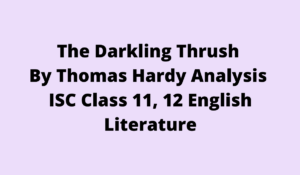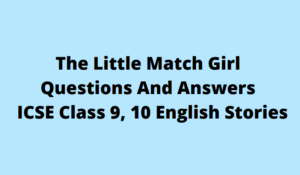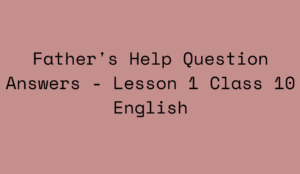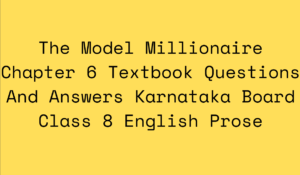The Merchant Of Venice Act 1 Scene 3 – ICSE Class 10 English
In this, you are going to go through The Merchant Of Venice Act 1 Scene 3 – ICSE Class 10 English. Understanding a text meticulously in its totality is very important for a learner for scoring better in the ICSE Board exam. Experts made ample to ensure a thorough script of The Merchant Of Venice Act 1 Scene 3. Let us find The Merchant Of Venice Act 1 Scene 3 – ICSE Class 10 English.
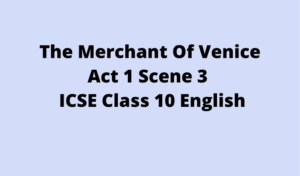
SCENE III. Venice. A public place.
Enter Bassanio and Shylock
Shylock
Three thousand ducats; well.
Bassanio
Ay, sir, for three months.
Shylock
For three months; well.
Bassanio
For the which, as I told you, Antonio shall be bound.
Shylock
Antonio shall become bound; well.
Bassanio
May you stead me? will you pleasure me? shall I know your answer?
Shylock
Three thousand ducats for three months and Antonio bound.
Bassanio
Your answer to that.
Shylock
Antonio is a good man.
BassanioHave you heard any imputation to the contrary?
Shylock
Oh, no, no, no, no: my meaning in saying he is a good man is to have you understand me that he is sufficient. Yet his means are in supposition: he hath an argosy bound to Tripolis, another to the Indies; I understand moreover, upon the Rialto, he hath a third at Mexico, a fourth for England, and other ventures he hath, squandered abroad. But ships are but boards, sailors but men: there be land-rats and water-rats, water-thieves and land-thieves, I mean pirates, and then there is the peril of waters, winds and rocks. The man is, notwithstanding, sufficient. Three thousand ducats; I think I may take his bond.
Bassanio
Be assured you may.
Shylock
I will be assured I may; and, that I may be assured, I will bethink me. May I speak with Antonio?
Bassanio
If it please you to dine with us.
Shylock
Yes, to smell pork; to eat of the habitation which your prophet the Nazarite conjured the devil into. I will buy with you, sell with you, talk with you, walk with you, and so following, but I will not eat with you, drink with you, nor pray with you. What news on the Rialto? Who is he comes here?
Enter Antonio
Bassanio
This is Signior Antonio.
Shylock
[Aside] How like a fawning publican he looks! I hate him for he is a Christian, But more for that in low simplicity He lends out money gratis and brings down. The rate of usance here with us in Venice. If I can catch him once upon the hip, I will feed fat the ancient grudge I bear him. He hates our sacred nation, and he rails, Even there where merchants most do congregate, On me, my bargains and my well-won thrift, Which he calls interest. Cursed be my tribe, If I forgive him!
Bassanio
Shylock, do you hear?
Shylock
I am debating of my present store, And, by the near guess of my memory, I cannot instantly raise up the gross. Of full three thousand ducats. What of that? Tubal, a wealthy Hebrew of my tribe, Will furnish me. But soft! how many months Do you desire?
To Antonio
Rest you fair, good signior; Your worship was the last man in our mouths.
Antonio
Shylock, although I neither lend nor borrow By taking nor by giving of excess, Yet, to supply the ripe wants of my friend, I’ll break a custom. Is he yet possess’d How much ye would?
Shylock
Ay, ay, three thousand ducats.
Antonio
And for three months.
Shylock
I had forgot; three months; you told me so. Well then, your bond; and let me see; but hear you; Methought you said you neither lend nor borrow Upon advantage.
AntonioI do never use it.
Shylock
When Jacob grazed his uncle Laban’s sheep– This Jacob from our holy Abram was, As his wise mother wrought in his behalf, The third possessor; ay, he was the third.
AntonioAnd what of him? did he take interest?
Shylock
No, not take interest, not, as you would say, Directly interest: mark what Jacob did. When Laban and himself were compromised That all the eanlings which were streak’d and pied Should fall as Jacob’s hire, the ewes, being rank, In the end of autumn turned to the rams, And, when the work of generation was Between these woolly breeders in the act, The skilful shepherd peel’d me certain wands, And, in the doing of the deed of kind, He stuck them up before the fulsome ewes, Who then conceiving did in eaning time Fall parti-colour’d lambs, and those were Jacob’s. This was a way to thrive, and he was blest: And thrift is blessing, if men steal it not.
Antonio
This was a venture, sir, that Jacob served for; A thing not in his power to bring to pass, But sway’d and fashion’d by the hand of heaven. Was this inserted to make interest good? Or is your gold and silver ewes and rams?
Shylock
I cannot tell; I make it breed as fast: But note me, signior.
Antonio
Mark you this, Bassanio, The devil can cite Scripture for his purpose. An evil soul producing holy witness Is like a villain with a smiling cheek, A goodly apple rotten at the heart: O, what a goodly outside falsehood hath!
Shylock
Three thousand ducats; ’tis a good round sum. Three months from twelve; then, let me see; the rate.
Antonio
Well, Shylock, shall we be beholding to you?
Shylock
Signior Antonio, many a time and oft, In the Rialto you have rated me About my moneys and my usances: Still have I borne it with a patient shrug, For sufferance is the badge of all our tribe. You call me misbeliever, cut-throat dog, And spit upon my Jewish gaberdine, And all for use of that which is mine own. Well then, it now appears you need my help: Go to, then; you come to me, and you say ‘Shylock, we would have moneys:’ you say so; You, that did void your rheum upon my beard And foot me as you spurn a stranger cur Over your threshold: moneys is your suit What should I say to you? Should I not say ‘Hath a dog money? is it possible A cur can lend three thousand ducats?’ Or Shall I bend low and in a bondman’s key, With bated breath and whispering humbleness, Say this; ‘Fair sir, you spit on me on Wednesday last; You spurn’d me such a day; another time You call’d me dog; and for these courtesies I’ll lend you thus much moneys’?
Antonio
I am as like to call thee so again, To spit on thee again, to spurn thee too. If thou wilt lend this money, lend it not As to thy friends; for when did friendship take A breed for barren metal of his friend? But lend it rather to thine enemy, Who, if he break, thou mayst with better face Exact the penalty.
Shylock
Why, look you, how you storm!
I would be friends with you and have your love,
Forget the shames that you have stain’d me with,
Supply your present wants and take no doit
Of usance for my moneys, and you’ll not hear me:
This is kind I offer.
Bassanio
This were kindness.
Shylock
This kindness will I show. Go with me to a notary, seal me there Your single bond; and, in a merry sport, If you repay me not on such a day, In such a place, such sum or sums as are Express’d in the condition, let the forfeit Be nominated for an equal pound Of your fair flesh, to be cut off and taken In what part of your body pleaseth me.
Antonio
Content, i’ faith: I’ll seal to such a bond And say there is much kindness in the Jew.
BASSANIO
You shall not seal to such a bond for me: I’ll rather dwell in my necessity.
Antonio
Why, fear not, man; I will not forfeit it: Within these two months, that’s a month before This bond expires, I do expect return Of thrice three times the value of this bond.
Shylock
O father Abram, what these Christians are, Whose own hard dealings teaches them suspect The thoughts of others! Pray you, tell me this; If he should break his day, what should I gain By the exaction of the forfeiture? A pound of man’s flesh taken from a man Is not so estimable, profitable neither, As flesh of muttons, beefs, or goats. I say, To buy his favour, I extend this friendship: If he will take it, so; if not, adieu; And, for my love, I pray you wrong me not.
Antonio
Yes Shylock, I will seal unto this bond.
Shylock
Then meet me forthwith at the notary’s; Give him direction for this merry bond, And I will go and purse the ducats straight, See to my house, left in the fearful guard Of an unthrifty knave, and presently I will be with you.
Antonio
Hie thee, gentle Jew.
Exit Shylock
The Hebrew will turn Christian: he grows kind.
Bassanio
I like not fair terms and a villain’s mind.
Antonio
Come on: in this there can be no dismay; My ships come home a month before the day.
Questions And Answers
What does Act 1 Scene 3 reveal about Shylock’s character?
The impression of Shylock created in Act 1, Scene 3, is of a complex individual. On the one hand, he comes across as a greedy, hateful man, a person one wouldn’t automatically trust. On the other hand, he earns sympathy due to the appalling abuse he suffers on a regular basis due to his being a Jew.
What is the theme of Act 1 Scene 3 in The Merchant of Venice?
Shylock embodies the play’s larger themes about hatred, both as a victim and a victimizer. Shylock is a victim of anti-Semitic hatred who turns that hatred back on the Christians who have wronged him.
What was Shylock debating in Act 1 Scene 3?
Shylock bears a grudge against Antonio because Antonio has been bringing down the rate of interest in Venice by lending out money gratis.
What is the irony in Shylock Act 1 Scene 3?
Shylock offers to give the loan of three thousand ducats if Antonio signs a bond with him that will entitle him to a pound of flesh from his body if he breaks the contract. It is ironic that he talks of friendship while talking of taking his life
Why did Shylock and Antonio hate each other?
Shylock has a bias against Antonio as a Christian and hates him even more for Antonio’s practice of lending money without interest, undermining Shylock’s usury business.
